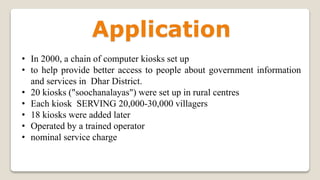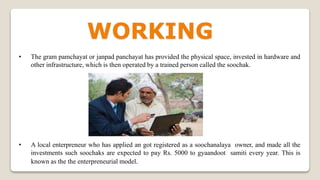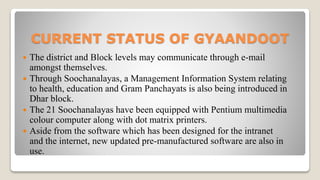Gyandoot
- 1. AN E-GOVERNANCE INITIATIVE: GYANDOOT Presented By: Himani Yadav Himani Singh
- 2. INTRODUCTION Intranet based G2C service Dhar District of MP in JAN 2000 cost effective , replicable economically self reliant and financially viable taking the benifits of ICT to the rural masses. Project involved setting up of low cost self sustainable community owned rural intranet terminals known as “Soochanalaya”.
- 3. Application • In 2000, a chain of computer kiosks set up • to help provide better access to people about government information and services in Dhar District. • 20 kiosks ("soochanalayas") were set up in rural centres • Each kiosk SERVING 20,000-30,000 villagers • 18 kiosks were added later • Operated by a trained operator • nominal service charge
- 4. OBJECTIVES • Ensure equal access to emerging technology- for marginalized • Create a cost effective , replicable, economically self reliant and financially viable ICT model FOR rural masses. • grass-roots entrepreneurial model • participation of non traditional entrepreneurs • Provide self employment through to local youth • Improve the quality, speed and sensitivity of the state delivery apparatus towards the needs of local customers/citizens. • Search for potential of rural markets in digital domain.
- 5. SOOCHANALAYAS Soochanalayas are 21 client sites / nodes working as rural cybercafe- cum-cyberoffices. Each Soochanalaya provides services to about 15 Gram Panchayats, 25 to 30 villages, 20,000 to 30,000 population. The intranet covered 5 out of 13 Blocks in the district and 3 out of 7 Tahsils in the district in the initial phase. The Soochanalayas are located on the roadside and are central villages where people normally travel. Soochanalayas have telephone.
- 6. WORKING • The gram pamchayat or janpad panchayat has provided the physical space, invested in hardware and other infrastructure, which is then operated by a trained person called the soochak. • A local enterpreneur who has applied an got registered as a soochanalaya owner, and made all the investments such soochaks are expected to pay Rs. 5000 to gyaandoot samiti every year. This is known as the the enterpreneurial model.
- 7. SERVICES OFFERED • Mandi Prices • Income certificate • Domicile certificate • Caste certificate • Land holder’s passbook • Rural Hindi mail • Grievance Redressal • Forms of Government Schemes • Employment news • Advisory module • Driving License • Khasra Nakal Avedan • Board Exam Results
- 8. Transparency and the Poor • Made specific effort at trying to assist disadvantaged groups. • This is seen in the choice of location in the identity of users targetted by information and service design; and in the identity of the kiosk operators. • In part, some of its identified problems derive from - and can arguably be offset against - its attempt to reach out to the poor.
- 9. CURRENT STATUS OF GYAANDOOT The district and Block levels may communicate through e-mail amongst themselves. Through Soochanalayas, a Management Information System relating to health, education and Gram Panchayats is also being introduced in Dhar block. The 21 Soochanalayas have been equipped with Pentium multimedia colour computer along with dot matrix printers. Aside from the software which has been designed for the intranet and the internet, new updated pre-manufactured software are also in use.
- 10. EXPANSION OF THE PROJECT • Some fundamental guidelines were framed for future expansion. • Centers to be opened only in the villages where local telephone exchange is near and fair connectivity, • New centers to be created through private investment. • New services and facilities to be introduced in phased manner.
- 11. PROBLEMS/WEAKNESS • Unresolved Grievances • Update of mandi prices not timely • Lack of English language skills • Neglect of service delivery due to hyped publicity • Delay in service delivery • Perceived backlash from officials • Inefficiencies in service delivery • New requirement of travel to Janpad Panchayat • Soochanalay is too far.
- 12. SUCCESS • Fully succeeded in generating awareness. • Youth are excited about the new employment opportunities arising out of ICT. • Government officials feel that Gyandoot has improved their accountability • The revenue generated is grossly inadequate to breakeven
- 13. AWARDS • CSI-TCS National IT award for the best IT usage, instituted by the Computer Society of India for the year 2000. • STOCKHOLM CHALLENGE AWARD 2000 • Sir Ratan Tata Trust Healthy Child Competition granted finance for children education.
- 14. Conclusion Gyandoot has fully succeeded in generating awareness. It has provided potential of rural markets in digital domain. Faster response from government machinery. Transparency in access mechanism - Anytime, Anywhere, Anybody.
- 16. THANK YOU.















